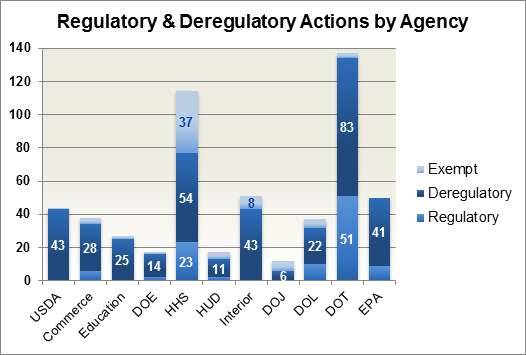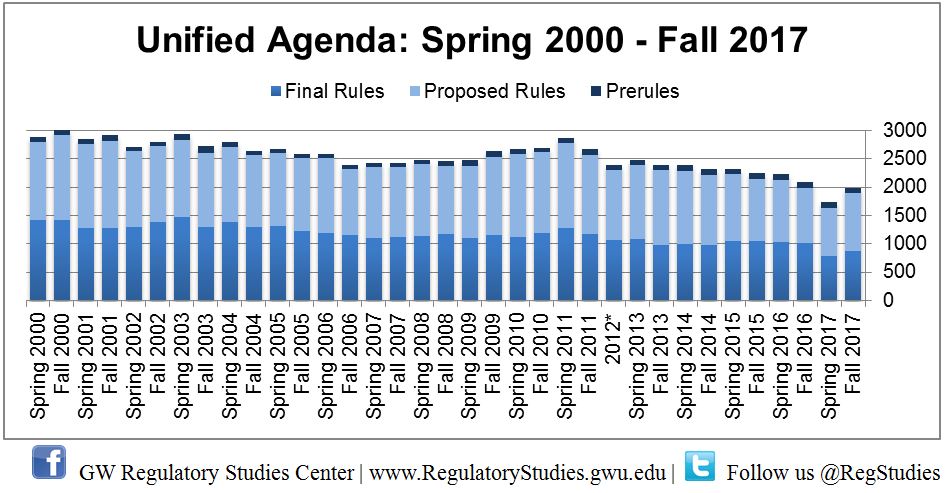On Thursday, the Office of Information and Regulatory Affairs (OIRA) in the Office of Management and Budget released its biannual Regulatory Plan and the Unified Agenda of Regulatory and Deregulatory Actions. The Unified Agenda provides the public with a look at agency priorities and regulations for the next year. In addition to the Unified Agenda, OIRA released a status report on implementation of President Trump’s two-for-one regulatory requirement, identifying 67 deregulatory actions finalized in fiscal year 2017 and setting regulatory cost caps for agencies in FY 2018.
“Reducing Regulation and Controlling Regulatory Costs”
Executive Order 13771, “Reducing Regulation and Controlling Regulatory Costs,” instructs agencies to identify two rules for removal for each new significant rule they issue after noon on January 20, 2017. Additionally, the EO instructs agencies to comply with a $0 regulatory cost cap for fiscal year 2017, meaning that the costs of new significant rules should be offset by the costs of the rules selected for removal or modification.
OMB’s status report lists each of the qualifying regulatory and deregulatory actions completed in FY 2017. The list includes three significant regulations, issued by DOE, EPA, and HHS, which are offset by 67 deregulatory actions to add up to $570 million in annual savings. While the 22-to-one ratio of regulatory offsets to new rules exceeds the two-for-one requirement, some of these deregulatory actions are extensions or delays of compliance dates, or withdrawals of proposed rules for which society has not yet borne any costs.
Regulatory Budgets in Fiscal Year 2018
In September, OMB released a memo instructing agencies to propose a FY 2018 regulatory cost budget for their agency representing a net reduction in total incremental regulatory costs. OMB’s status report lists agencies’ FY 2018 regulatory budgets, all of which are for negative or zero regulatory costs.
The Department of Interior and the Department of Labor (DOL) have the lowest regulatory budgets in terms of annualized cost savings, at -$196 million and -$137 million respectively. In terms of total cost savings, the lowest budgets are for the Department of Defense (-$1 billion), DOE (-$1.1 billion), DOL (-$1.9 billion), and the Department of Interior (-$2.8 billion). DHS, Treasury, GSA, NASA, OMB, and the Social Security Administration are among the 8 agencies with a fiscal year budget of $0. In total, the administration expects that these ongoing reforms will reduce overall regulatory burdens by $9.8 billion.
Regulatory Reform Transparency
How will agencies meet these cost reduction requirements? In contrast to the Spring 2017 Agenda, the Fall 2017 Agenda shows which planned agency actions are regulatory or deregulatory, allowing observers to know how the Trump administration plans to implement its deregulatory policies.

Among the top regulatory agencies selected for review, DOT and HHS have the most deregulatory activities planned in the next year, at 83 and 54 respectively. Several agencies, including USDA, the Department of Education, and Interior, have no qualifying regulatory actions planned. However, these agencies do have a number of planned regulations which are listed as being either partially or fully exempt from the two-for-one requirements of EO 13771.
What’s in the Fall 2017 Agenda?
Overall, the 2017 Agenda identifies 3,521 regulatory actions at different stages of development. Of these, 470 have recently been completed, and 762 are long-term. The Agenda classifies the remaining 1,977 as active regulatory actions, divided into three categories based on stage of rulemaking: final rule, proposed rule, and prerule stage. In comparison to previous Agendas, the 2017 Agenda contains about 23% fewer active regulatory actions in all rulemaking stages combined.


